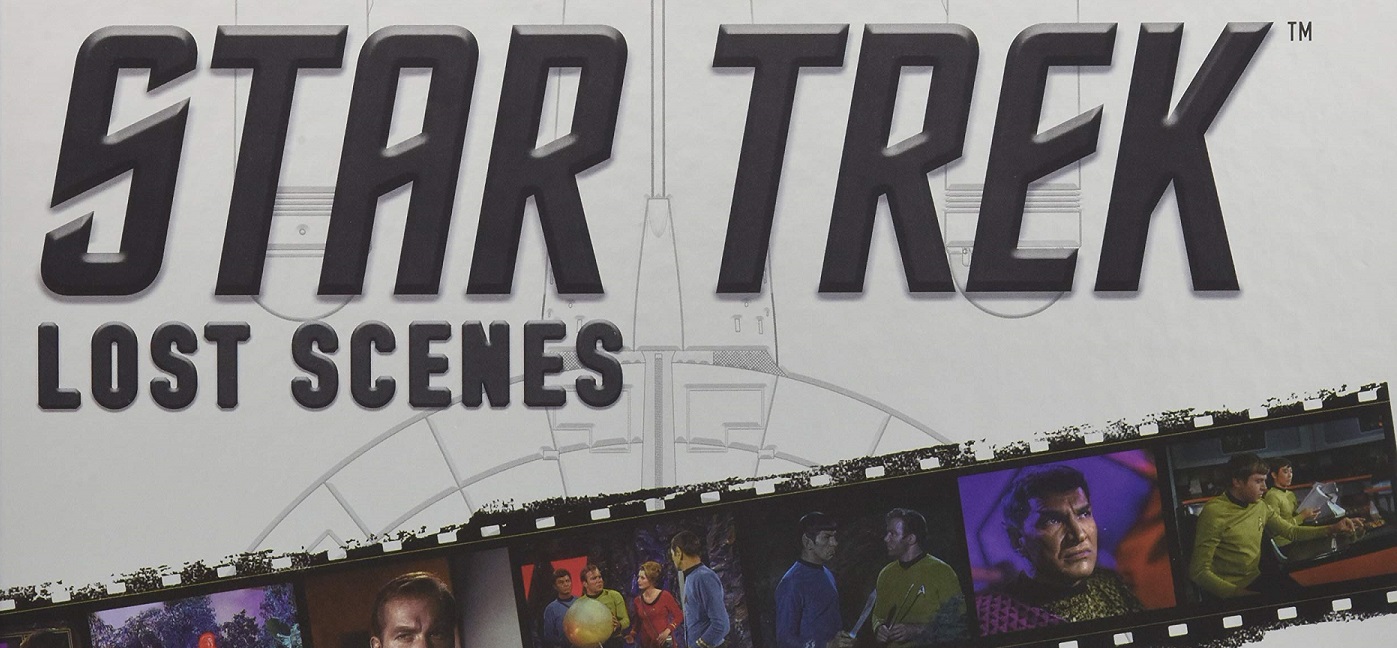
Welcome back! We’re here with the second and final part of our interview with ‘Star Trek: Lost Scenes‘ authors David Tilotta and Curt McAloney. If you missed the first part, well, what brings you here? Go check it out! I’ll wait.
As for the book itself, it represents the latest addition to the canon of ‘Star Trek’ reference works and something of an unusual one at that. By compiling film clips (single-frame clippings of film from the show) that were sold by Gene Roddenberry’s mail order merchandising company Lincoln Enterprises, the authors were able to present a unique look behind the scenes, including bloopers, production insights and – as the title implies – reconstructing deleted scenes.
In the first part of the interview, we focused on their history with ‘Star Trek’ and the book’s background. Here, we discuss the challenges and surprises that accompanied the book’s production, and David shares a story of some priceless footage that was found in the last place you’d expect.
You mentioned approaching the book with the notion of educating people, and that was one of the things that most struck me as I was going through my copy. I’m a lifelong ‘Trek’ fan and a movie geek on top of that. So I’m not unfamiliar with things like bluescreens or the split screen effects, but I had never seen the process behind them laid out in the way it is here. It was fascinating.
CM: To quote a Vulcan! [laughs]
DT: That’s good. I hope it was laid out in a good way.
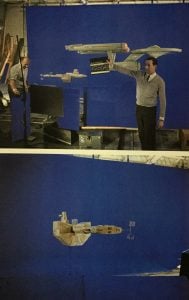 I thought so. [laughs]
I thought so. [laughs]
CM: Yeah, we wanted to make sure that it was user-friendly, so to speak.
DT: We didn’t just want to throw a bunch of pictures in the book and have people just go from page to page through all this randomness. We wanted a good, solid organizational structure, and an educational one was an easy one, I think. It still took a lot of work. As Curt said, years.
CM: Yes, and the text of it is really… Dave did an excellent job explaining things. It’s interesting, in the Amazon reviews, one guy gave it like one star. And he’s like “Oh, I’ve seen all this stuff before.” And it’s obvious he just flipped through and saw some pictures, right? And then after he went back and started reading through it, he made a revision and gave it five stars. He said, “You know, once I started looking into the depth of this, this is really pretty cool!” So people need to take the time to… It’s fun to just page through it, but there’s a lot of meat to it.
That was something I tried to highlight in my own review. That I didn’t quite know what to expect when I first opened it up. So the whole thing was really a pleasant surprise.
DT: Yeah, thank you.
CM: Oh, and I love the glowing review from Doug Drexler. He was so nice in what he wrote in the foreword.
I was actually just reading that earlier today.
CM: What was your most surprising part about the book? Some of the scenes that you never expected?
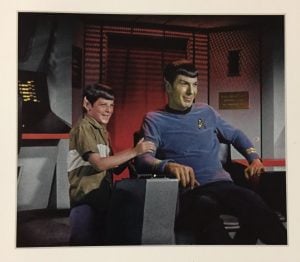 Some of that, yeah. Some of it is just cool to see. One thing that sticks in my mind is the picture of Leonard and Adam Nimoy that you opened the blooper section with. That and some of the earlier stuff, like the shots of the studio models or the makeup tests from ‘The Cage’.
Some of that, yeah. Some of it is just cool to see. One thing that sticks in my mind is the picture of Leonard and Adam Nimoy that you opened the blooper section with. That and some of the earlier stuff, like the shots of the studio models or the makeup tests from ‘The Cage’.
CM: If I can talk a bit about the process because that’s part of the reason it took a long time. These film clips – there’s a picture of an outtake between Spock and Kirk in the beginning of the book – one of the pictures, it shows on the top, is kind of reddish colored. It’s got a reddish, orange-ish look to it. You can see scratches and dirt on it. That takes a while to clean up. It’s not like you go “autocolor” and then it magically fixes everything. The problem is that… They’re called channels, in Photoshop. This is getting kind of technical, I don’t know if you want to get into it or not. But when this film would degrade over time, it would lose different layers of color. And we would have to basically reinvent that color, but put it back into the clip that we were viewing, to give it that sparkle, that edge that it would’ve had originally. And so we used a lot of clips for reference. Like, “Okay, we’re not quite sure what color that glow is on the back wall, but we’ll check out a clip from the episode that’s similar.” So there’s a lot of that going on, a lot of research. Not only in how the things were made but how they looked.
So on that note, what would you say was the biggest challenge in putting all this together?
CM: Well for me, that whole process. I mean, how many clips do we have, Dave?
DT: In the book? Seven hundred and… fifty-ish. So quite a bit. I think from the writing standpoint, the biggest challenge was probably in the behind the scenes section. In the special effects areas, trying to figure out how they did a lot of the effects and the procedures and techniques that they used. The original series used a lot of different effects houses to do a lot of the effects. They all used different techniques. The transporter beam was done differently by different houses. And unfortunately, most of the people who worked on the original series are no longer with us. So we had to spend a lot of time sifting through the film clips, looking at the visual evidence we had, looking at the archives at UCLA and others, talking to a few people. Just trying to figure out, “Gosh, how did they actually do this?” and coming up with the right way. So that was challenging.
CM: To give you an idea of some of the research, we’ve done a bunch of little one page articles for StarTrek.com. Like we’ll cover an episode based “fifty years ago…,” that kind of thing. And so we were thinking of doing a thing on ‘Shore Leave’. And the area where they shot that exterior was called Africa, USA. In 1969 it flooded and basically destroyed the area. A lot of animals had to be rescued. It was also where they shot ‘Daktari’. They had a lot of lions and chimps and stuff. So anyway, we had been trying to do some research and on how the flood came in because it’s all going to be part of this article, and it is just like pulling teeth to find out information! You’d think there’d be tons of photos about that, but we had to go look through archives of the Los Angeles Times to find out stuff. Sometimes it’s just a real Sherlock Holmes thing trying to find out stuff.
DT: Yeah, and if I can springboard off that, it brings up a really good point in that you don’t know what you don’t know. And you go to various websites – you probably know what they are – and they have encyclopedic lists of everything about ‘Star Trek’ that you need to know. Errors have crept into those kinds of sites over the years. You’ll go to a site and look for “What’s going on in Africa, USA today?”. And some sites say, “Well that’s where a big game preserve is located.” Well, in fact, we found out that ultimately that’s not where the big game preserve really is today. I think it’s an RV park today. Point being, we basically had to assume that we were starting from scratch. So we tried, where possible, to investigate each and every little fact. And we assumed that over the years there were enough errors sort of accumulating that we just couldn’t take anything at face value, so we tried to double check things. And we found that some things that fans have assumed over the years are incorrect. There’s a lot of stuff that had been creeping in, if that makes sense.
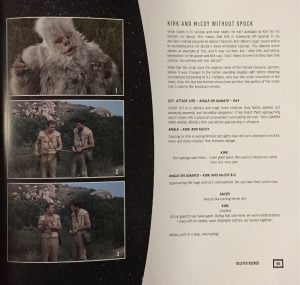 Are there any other examples of that sort of thing that come to mind?
Are there any other examples of that sort of thing that come to mind?
DT: I think the big one off the top of my head is the Mugato/Gumato. [laughs] If you look at the script for the episode, it’s listed as “Gumato.” And over the years, the fans started to talk about the fact that, well, it was changed to “Mugato” because De Kelley could pronounce “Gumato.” And you know, I think we started thinking about that, going, “Gosh, De Kelley was a professional actor! He did this for a living. Is it really believable that he couldn’t pronounce that word or had problems with it?” And so we asked a friend who knew Dorothy Fontana. And she came back and said she’d never heard that rumor before, that the bottom line was they just thought Mugato sounded better than Gumato. That’s an example that comes to mind. There are others in the book.
As you were putting the book together, was there anything that you came across – maybe something you hadn’t seen in a while from your own collection or something new – that made you go, “Wow, I can’t believe we found that!” or “I can’t wait for people to see this!”?
CM: We’re kind of jaded because we’ve seen all this stuff for so long.
DT: And they’re all our children, so we love every one of them. Let’s see, I guess I’ll jump in and say a couple deleted scenes that I thought were pretty interesting. One was the scene that was cut from ‘The Gamesters of Triskelion’ that basically shows Uhura throwing the Drill Thrall across the room in her cell. The way that sequence was edited, it made Uhura sort of…
CM: A damsel in distress.
DT: Yes. Well put. But the way it was originally shot was that she threw this guy across the cell, so she was…
CM: Kicking ass!
DT: Exactly! She kicked his butt! And it was a really interesting editing choice to cut all that out. I can’t believe that. It really changes the whole flavor of that scene. So that was a big one for me.
CM: I thought it was kind of humorous, but it never really added to the storyline, which is probably why it was cut. But from ‘The Savage Curtain’, where Lincoln is having this long extrapolated talk where he speaks in nineteenth-century terms about, “Oh, are we floating in the air above…?” “No, we’re in space. This is a vacuum.” All this back and forth that… It was interesting, but it didn’t really push the story along, so you could kind of see why they’d cut it out. The thing that I’ve always wondered was, when they make a decision like that, you’ve gotta make up for that time. I mean they don’t just shoot extra stuff purposely, you know? That must’ve been three or four minutes, so what did they do? Just extend the fight scenes? That’s the one question I still think about. Another thing that I found interesting is a short scene from the third season where.. What was it, Platonians?
DT: ‘Plato’s Stepchildren’.
CM: ‘Plato’s Stepchildren’. And Kirk is crawling on his belly, doing this long soliloquy that I think is from Shakespeare? Big chunk of a memory hog for the brain, you know, while you’re doing that! [snaps fingers] Cut out.
DT: And he’s kissing Parmen’s robe at the end, yeah. That’s a good point, though, that’s a lot of dialog for anybody to remember.
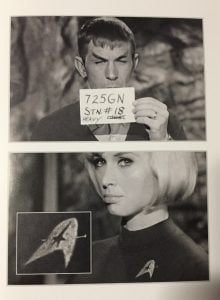 Now, once this interview was booked, there was one question I knew I had to get in. You mentioned in the introduction that one of you has a film roll from ‘Friday’s Child’ that you found in the trash. That has to be a good story.
Now, once this interview was booked, there was one question I knew I had to get in. You mentioned in the introduction that one of you has a film roll from ‘Friday’s Child’ that you found in the trash. That has to be a good story.
DT: Yes it does! [laughs] It’s really interesting, though. ‘Star Trek’ was a popular series with a lot of people while it was on, as you know. And when it was cancelled, a lot of people were really upset about it. And some of those people lived in California, and they were able to get access to the trash that the studio was throwing out. And they grabbed some of the stuff, took it back, and found that in some of the garbage bags there were all kinds of stuff that the producers had gotten rid of. Because ‘Star Trek’ was not a successful series, we have to remember that. It wasn’t doing the best and they wanted to move on. As far as the studio was concerned it wasn’t going to amount to anything. And so a lot of stuff was thrown away and discovered in trash bags. And not only film, by the way, but some of the props.
CM: Audiotape.
DT: Audiotapes, exactly. And some of the props I’m thinking of that I know were found in garbage bags include the parasites from ‘Operation: Annihilate!’, some of the cubes from ‘By Any Other Name’. What else? A lot of the necklaces from ‘I, Mudd’ were found and a lot of film. So this film was found and it sat in the garbage bag for decades. It was in someone’s garage before they realized, “We oughta do something with this.” And they actually sent it to me thinking that I could cut it up and use it for film clips, maybe sell it. And I started looking at it, what it was, and I realized, “This is from a deleted scene! This is film that’s never been cut up, never been seen before!” And so we had it digitally transferred and restored it as much as we could. And to this day it’s pretty interesting because we get contacted by people periodically who relate similar stories to us, that they found rolls of film in attics, here, there, and wherever. And they say, “Can you transfer this?” We’ve got bloopers and all kinds of stuff that we have to figure out what we’re going to do with that came from discovered film.
CM: What was the story about – we have it on the website – about “29D” or whatever the scene was. The one with Garth of Izar?
DT: Yeah! ‘Whom Gods Destroy’.
CM: That was sent to you originally, right?
DT: It was, and that was obtained from the son of one of the people that worked in one of the labs who just happened to find that film.
CM: And it was an actual negative.
DT: Right, we found the negative of that.
The negative?! That’s incredible!
DT: I mean again, back then ‘Star Trek’ was simply not a successful series, and a lot of the stuff is just seen as junk. And we’re fortunate that people are finding this “junk” laying around.
CM: Bean counters have a tendency to not really have an eye on the future, that what’s once considered trash can become treasure. I mean a lot of videotapes, like entire seasons of ‘Doctor Who’ were repurposed by the BBC to shoot other things. And I’m sure that they were thinking “Well, this ‘Star Trek’ stuff, all it’s gonna do is accumulate shelf space and cost us rent on that, so…”
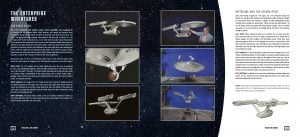 Yeah, I was actually just thinking that what so much of this conversation calls to mind is how every so often you hear stories about someone finding a lost episode of ‘Doctor Who’ at a yard sale or whatever.
Yeah, I was actually just thinking that what so much of this conversation calls to mind is how every so often you hear stories about someone finding a lost episode of ‘Doctor Who’ at a yard sale or whatever.
DT: Yeah, exactly. Exactly.
And finally, do you have any follow-up projects or final thoughts you’d like to share?
CM: Well it would be nice if we got some people to write in to CBS and say “Hey, how about a sequel?” [laughs]
That’s right! You do have another three hundred pages or so to work with!
CM: We do have enough content for another book because we had to make it within their parameters, their range of page count. Because they’ve got it all figured out mathematically as to how much they can do and make a profit. So yeah, there’s a lot of extra stuff.
DT: Yeah, we could easily do another book. But I don’t want to get out without saying that we’re really grateful to CBS and Titan Books. CBS, they were fantastic throughout this whole process. Big, big ‘Star Trek’ fans there. We worked closely with John Van Citters who was just extremely supportive and very helpful. I just can’t say enough good things about them. And it’s just been great working with Titan. Titan is very easy to work with.
CM: The whole process with everyone has been very nice. The Okudas are great people, and Paula, she’s just wonderful. We still have correspondence with her. She was really excited for us when the book came out. It’s been a real pleasant experience. It was getting really… When we had the deadline and things were being pushed and we were running late on stuff. Because we both have regular jobs. So we always had to do this on the side, and boy, that got to be tough sometimes!
DT: Yeah, a lot of late nights!
Thanks once again to Curt and David for their time, and of course for all the work that went into the book. ‘Star Trek: Lost Scenes‘ can be found on Amazon or anywhere books are sold. And as always, make sure to check in with ScienceFiction.com for the latest on upcoming ‘Star Trek’ film and television projects – including the second season of ‘Star Trek: Discovery’ – as it becomes available!
